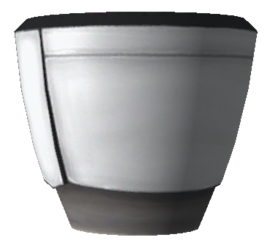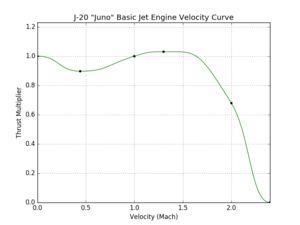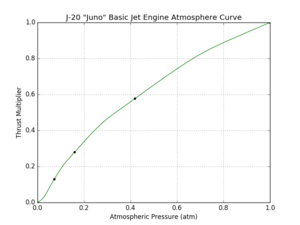J-20 "Juno" Basic Jet Engine
| J-20 "Juno" Basic Jet Engine | ||
| Jet engine by C7 Aerospace Division | ||
| Radial size | Tiny | |
| Cost | (total) | 450.00 |
| Mass | (total) | 0.25 t |
| Drag | 0.2 | |
| Max. Temp. | 2000 K | |
| Volume | ? | |
| Impact Tolerance | 7 m/s | |
| Research | | |
| Unlock cost | 2 000 | |
| Since version | 1.0.5 | |
| Part configuration | SmallJetEngine.cfg | |
| Jet engine | ||
| Maximum thrust | 20 kN | |
| Isp | (max) | 6400 s |
| Fuel consumption | 0.06 | |
| Intake air consumption | 1.40 | |
| Thrust vectoring | No | |
| Testing Environments | ||
| On the surface | Yes | |
| In the ocean | Yes | |
| On the launchpad | Yes | |
| In the atmosphere | Yes | |
| Sub orbital | No | |
| In an orbit | No | |
| On an escape | No | |
| Docked | No | |
| Test by staging | Yes | |
| Manually testable | Yes | |
The J-20 "Juno" Basic Jet Engine is the first air-breathing engine to unlock in the Tech tree. It uses liquid fuel and intake air. It is a turbojet, and the most basic jet engine in the game, hence the name. Although it is inferior to the later jets in terms of thrust, fuel efficiency and speed capability, it yet is the first engine allowing for reasonable extended atmospheric flight. It is also the only jet engine with a tiny form factor, allowing for some fun ultra-light builds.
Performance and usage
Being the most basic jet engine, it lacks many of the defining traits of more advanced models. The Juno is the only turbojet in the game, while the other jet engines are turbofans. Regarding its performance stats, it can be counted to the low-speed engines, as well as the bigger J-33 "Wheesley" Basic Jet Engine and the enormous J-90 "Goliath". Having the same thrust-to-speed behavior, it has a considerable lower fuel efficiency and no thrust reverse. Note that 'low fuel efficiency' has to be seen only referring to jet engines, as it is still better than all (atmosphere-usable) rocket engines by a factor of 20.
As with all jet engines, its thrust decreases significantly with altitude. Its maximum stationary thrust is rated at 20 kN at sea level. At about 8,000 m it generates just 10 kN, and at about 15,000 m it generates no more than 3.3 kN, ceasing to work entirely at about 18,300 m. Note that the behavior between these points (as shown in the part stats) is slightly non-linear.
Thrust output also varies with speed, although far less than on the more advanced engines. Similar to the other two low-speed engines, its thrust does not notably increase with speed, in contrast to the high-speed engines. Up to Mach 0.5 the thrust drops to about 80%, recovering to 105% at about Mach 1.5. Going faster, the thrust drops considerably quick, limiting usage to about Mach 2.1.
The Isp stays constant over the full range of application, which is a big change compared to KSP in pre-1.0 versions. It is rated at 6,400 s, putting it in the middle range of the Jet engines, with even the J-404 "Panther" Afterburning Turbofan high-speed jet being more efficient. As it is capable of sustained Mach 2 flight even with lowest tech plane parts, it is well suited low and partly medium range flight, while fuel efficiency makes longer range trips difficult, unless the pilot is very patient (Jeb is not...) and low speed is not a problem.
Its tiny (Mk0) size makes it useful for fuselage-mounted engines when used with the Mk0 Liquid Fuel Fuselage and the Small Circular Intake. Note that there are no aerodynamically-shaped command pods which share the same Mk0 size as the J-20, however many Probodobodyne Inc cores have the same general diameter. This engine is not for impatient pilots, as its acceleration is minimal, especially on the bumpy level 1 runway in early career mode.
Overall, it works best between 8,000 and 12,000 m altitude. Flying lower, the high air resistance requires more thrust which lowers the fuel efficiency, while in higher areas the engine's thrust output is simply too low for reasonable performance in flight.
Note that currently, the only planets which this engine will work on are Kerbin and Jool's moon Laythe.
Product description
| “ | A small turbojet. Not very efficient, anemic thrust, but hey--it's cheap! And it's so cute...look at the little thing! — C7 Aerospace Division |
” |
Trivia
The Juno may be named after the Junkers Jumo 004, one of the first jet engines.
Changes
- Initial release


